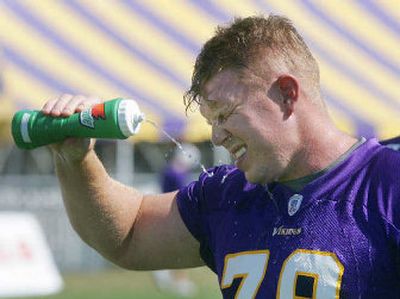BIGGER isn’t always better

When it comes to size, Americans tend to live by the credo that bigger is better. And when it comes to football players, teams usually borrow the motto of the drive-through window: Supersize ‘em, please.
Minnesota Vikings center Matt Birk recalled that when he entered the NFL in 1998, a 300-pounder was considered a big guy. Now, 300 is the new 275. The league has become as obsessed with the scale as an Atkins dieter, courting some unhealthy consequences in the process.
In April, University of Minnesota center Greg Eslinger fell victim to the numbers game when his 6-3, 293-pound body outweighed his award-heavy resume at the NFL draft. The winner of the Outland and Rimington trophies was deemed too small and wasn’t picked until the sixth round. About a month later came news of two more studies indicating the NFL’s largest players face an increased risk of heart disease, echoing the findings of previous research.
Both stories share the same moral: Bigger is not always better. But in today’s NFL, as in today’s America, that sensible philosophy is a hard sell.
“It seems like you have to be at least 300 pounds now (in the NFL),” said Birk, who is 6-4 and 308. “For me, carrying 300 pounds is a little bit of a strain on the body.
“We’re well aware of (the health studies). In your 20s and 30s, it’s something you joke about more than anything. I’m sure not too far down the road, that’s something that will hit home a little bit more. But it’s a physical game, and guys keep getting bigger, stronger and faster.” The Vikings’ training-camp roster includes 20 players who surpass the 300-pound mark, topped by 6-8, 343-pound Bryant McKinnie. In 1986, there were 10 NFL players who weighed 300 pounds or more; last year, there were more than 330 on opening-day rosters.
Birk said the growing size of NFL linemen mirrors the expanding girth of the population at large, and he added that advances in nutrition and training techniques now enable players to carry more weight and retain speed and athleticism. The evolution was sped along by rule changes that favored bigger players, as well as the emergence of Chicago defensive lineman William (Refrigerator)’ Perry as a cultural icon.
All those factors contributed to football’s version of an arms race, sometimes to the detriment of men on both sides of the 300-pound line. Because Eslinger fell below it, many of the virtues that made him one of the most celebrated Gophers in years – his work ethic, his intelligence, his selflessness, his heart – were sadly overshadowed.
“Effort level, commitment, doing all the right things, being smart, that’s all part of it,” Gophers assistant coach Gordy Shaw said. “But some people in the NFL still go to the tape measure. It’s almost like they ignore the (game) film.”
And for those who weigh in above the line, the NFL jackpot could be a Faustian bargain. The two studies recently released show that retired NFL linemen have high rates of metabolic syndrome, a group of cardiovascular risk factors that include high blood pressure and obesity, and are 50 percent more likely than other retired players to have an enlarged heart, another risk factor for heart disease and stroke. Other research has shown they are far more likely to have sleep apnea and other health issues.
NFL officials have dismissed some of those studies, but Commissioner Paul Tagliabue said last summer that the league is conducting its own research. It should do so seriously, and it should not fear the results.
Football is a big person’s game, of course, and its inherent danger creates part of its appeal. Americans fill stadiums on fall weekends to stand in awe of giants and cheer the naked chutzpah of people who willingly stare down bodily harm. But to dismiss a player such as Eslinger as too small – or to ignore size-related health risks, effectively turning them into the elephant in the corner of the locker room – does a disservice to both the players and the game.
Eslinger finally was picked by Denver, one of a few NFL teams whose offensive scheme relies on quicker, more agile linemen. He fits into their system well, setting him up for success – which would be the best revenge.
That’s what Shaw is counting on. “I called him as soon as he was drafted,” he said. “I told him, ‘Congratulations. You went (one pick) higher than (New England quarterback) Tom Brady.’ I guess some people didn’t think Greg was big enough. But people make mistakes.”